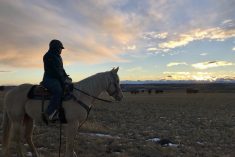Sean Firth made the jump from observer to active participant in January 2008 when he bought the Maritime Cattle Market in Truro, Nova Scotia. He gave it a new name, Atlantic Stockyards Limited, along with new ownership, but kept a lot of the familiar services that have turned this market into something of an institution in Maritime Canada. A bit of the old, a bit of the new: Firth is convinced this is a formula for a prosperous auction market in his part of the country.
The purchase marked a startling change from the first 19 years of his career, which he spent on the theoretical side of the beef industry. That’s his term for his life as a ruminant specialist with the Nova Scotia Department of Agriculture from 1989 to 2000 and later with AgraPoint International, an agricultural consulting firm based in Kentville, from 2001 until 2008.
Read Also

Reintroducing fire to Saskatchewan pastures
Pastures evolve over time. Woody plants and shrubs, which cattle can’t eat, may encroach on natural grasses. Invasive species, such…
“I made the move from theoretical to practical because owning a sale facility is the ultimate extension tool,” says Firth. He now works with farmers where it counts… on the when, what and how of marketing their yearly production.
He admits it is a serious job. “Most beef farmers market once a year and they need to get it right,” he says. He firmly believes in the industry but says it needs to be competitive and sustainable. “Not just sustainable, but able to grow and prosper,” he adds.
Firth credits the success of the stockyards to the time and effort put into it by Frank Berkelaar. Frank started at the Truro Livestock Market at the age of 19, working in the pens for the original owner, veterinarian Brian Nettleton. In time he became the market’s auctioneer and then bought the operation in 1974. It was Berkelaar who introduced the regular Thursday sales and special feeder sales in spring and fall. Frank was inducted into the Atlantic Agricultural Hall of Fame in 2008, the same year he sold the market.
Firth was busy planning the fall feeder sales schedule starting in September when visited by CANADIAN CATTLEMEN. He continues to sell farm equipment on the side, and while it is a growing part of the business, he says his future with the stockyards is closely tied to the health of the cattle business. “Our industry has always been grass-based and tied to the hip of the PEI potato industry. If we continue to build on our grass strengths, keeping our costs low, we will be around for the long term.”
“I need to make sure that producers know which feeders are selling for top prices and to ensure that producers have the information they need to market the best animals they can. The basics always apply — good genetics, calves that will grow and provide high-yielding carcasses, and properly prepared, no-intact males, no horns, vaccinated with the right vaccines at the right time. If producers meet these basics they will market high-value calves,” he says.
Firth believes the worst is over for beef producers and those who remain in the business will enjoy better times ahead. “In terms of price, the worst is over and if Canada can export beef and enjoy strong domestic demand we will have good years,” he says.
Ernie Mutch, president of the Prince Edward Island Federation of Agriculture, pins his hopes on the Island beef industry once again enjoying some good years. He says a lot of cow-calf farmers from the Island sell direct to feedlots, but added, “A lot of feedlots have shut down in the past year, so some really depend on taking calves to the Truro stockyards.”
“People still have to eat and therefore, food has to be produced, but we have lost a lot of our beef people in the last few years.”
While Atlantic Stockyards is still an integral part of the Island beef industry and should remain that way, Mutch says, “The beef industry will have to turn around.”
Firth believes it is heading for a profitable period if the industry can continue to expand its export sales. In Eastern Canada he is looking for some of this resurgence to come from the rebirth of the local food movement. “I don’t necessarily mean small-scale, isolated direct-market operations, but I do mean growth of regionally produced food. This will be driven by prohibitive transportation costs driven by prohibitive fuel costs,” says Firth.
Growing demand for regional foods would lead to sustainable regional agriculture (similar to what the Maritimes had in the past). “Agriculture will recover,” concludes Firth. “The trick is to be around when it happens.”
Determined to be one of those who are still around, Firth has been upgrading his facilities in Truro. The outdoor pens to the north were replaced this spring giving the market an expanded holding capacity of 300 to 500 head outside of the main barn. This renovation included the move to integrate RFID readers into the layout and upgrading of the management/office software. “More of our buyers are asking for this and I wanted to leverage RFID tags for inventory management at the sale barn,” he explains.
He also plans to continue to develop vaccinated calf sales during the fall run and encourage the marketing of age verified cull cows. A better load manifest system is another improvement that is underway. And there is no sign that Firth plans to stop there.
“My future is directly tied to the health and maintenance of the industry,” he says.















